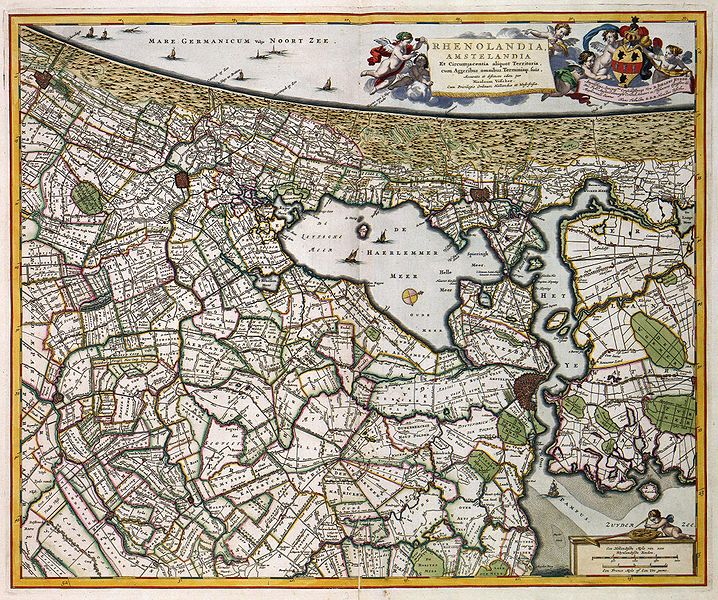The IJ Amsterdam
- Details
- Category: Amsterdam
The IJ is a lake, formerly a bay, in the Dutch province of North Holland. It is known for being Amsterdam's waterfront. Sometimes it is wrongly considered as a river.
 Dutch people simply call it the IJ, a Dutch word fallen into disuse meaning water. This name derives from the West Frisian word ie "stream, small river" (from Germanic *ahwō "water") and is cognate with Dutch Aa/Ee names for bodies of water. In Dutch, the name consists of the digraph ij, which behaves like a single letter. Therefore, both letters are capitalized; cf. IJmuiden, IJsselmeer.
Dutch people simply call it the IJ, a Dutch word fallen into disuse meaning water. This name derives from the West Frisian word ie "stream, small river" (from Germanic *ahwō "water") and is cognate with Dutch Aa/Ee names for bodies of water. In Dutch, the name consists of the digraph ij, which behaves like a single letter. Therefore, both letters are capitalized; cf. IJmuiden, IJsselmeer.
Geography
Today, the IJ is in two parts, the Binnen-IJ (inner IJ) or Afgesloten-IJ (closed IJ), and the Buiten-IJ (outer IJ). These two lakes are separated by a set of locks.
To the west, the Binnen-IJ is directly connected to the North Sea Canal, where the Port of IJmuiden and the North Sea can be reached.
To the east, the Buiten IJ is an extension of the IJmeer and Markermeer.
History
There are several theories about the origins of the IJ. Perhaps the IJ began as a stream, following a breakthrough in the dunes of Castricum. More likely, the IJ is a remnant of a northern arm of the Rhine delta. Finally, the IJ could also come from the lake Almere or Flevo. During the Roman period the IJ communicated on one side with the lake Flevo and the Vecht (Utrecht) and the other with the North Sea. Connection with the North Sea has subsequently disappeared, while the IJ in the Middle Ages has expanded. This is due to the emergence of the Zuiderzee, itself a bay of the North Sea resulting of a number of storms.

Plans were put forth to reclaim both the Haarlemmermeer and the IJ and turn them into polders. The Haarlemmermeer was first, falling dry in 1852, and the largest part of the IJ followed suit between 1865 and 1876, with only a small lake remaining at Amsterdam that was closed off from the Zuiderzee by the Oranje locks. At the same time, the North Sea Canal was constructed in the former IJ basin to provide Amsterdam with access to the sea again and revive its ailing port. It cut through the isthmus to connect to the North Sea near the town of Velsen; a new port, IJmuiden ("Y-mouth") was built at its west end. The east end of the IJ polders near Amsterdam was given over to industry, and a large new seaport area was constructed.
The Buiten IJ hosted the mixed dinghy sailing events for the 1928 Summer Olympics in neighboring Amsterdam. It also hosted two events for the 1920 Summer Olympics in Antwerp.
Latest articles
- Accommodatie Eurovisie Songfestival 2020 - Rotterdam
- Vermeer - famous Dutch painter from Delft
- Delft - Oude Kerk - Old Church
- Delft
- Enkhuizen - Havenweg - streetview - Google Maps
- Alkmaar - cheese market - Waagplein - streetview - Google Maps
- Hoorn - city center - Roode Steen - streetview - Google Maps
- Veere - Townhall - streetview - Google Maps
- Middelburg - Townhall - streetview - Google Maps
- Vlissingen - Smallekade - streetview - Google Maps
- Zierikzee- streetview - Google Maps
- Oosterschelde- streetview - Google Maps
- Haringvlietdam - Haringvlietsluis - streetview - Google Maps
- Hollands Diep - streetview - Google Maps
- Moerdijk bridges - streetview - Google Maps
- Harlingen - streetview - Google Maps
- Stavoren - streetview
- Dokkum - streetview
- Giethoorn - streetview
- Claire Morgan The Sound of Silence - Noord Brabants Museum
Visitors for Visitholland
We have 160 guests and no members online

